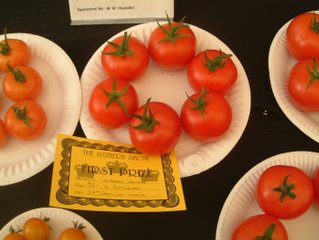

At most shows the beetroot class is well contested as everyone seems to grow it. But you need to know a few things to be able to win the class.
I sow several rows spaced a week apart from early May until the beginning of June. This allows me to cover the show period from late August to early October. If you choose a monogerm variety such as Red Ace then there is less need for fiddly thinning. Most beetroot varieties are actually seed clusters that can result in 3 or more seedlings coming through.
The rows need to be well watered during the summer and not allowed to dry out as this can cause corkiness around the shoulders. To prevent this the whole shoulder needs to be regularly covered over with moist soil, but this can be laborious and in any case there is a way of combatting this during the washing process (see below).
I read somewhere that the internal colouring of beetroot can be inproved by the addition of salt in the watering can. I don't know if this actually does help but it certainly hasn't caused any harm when I've tried it.
I like to lift my beet a day before the show so that I'm not rushing about too much. Each root should be about the size of a tennis ball, slightly smaller preferably but certainly no bigger. And there should be a nice long central tap root coming from the exact centre of each. Sometimes these tap roots can fork a few inches down but I snip off any excess roots to give the impression of one single long tap root. Discard any specimens showing signs of slug or pest damage and retire the kitchen sink.
Wash off any loose soil under running water and scrub gently with the soft side of a scouring pad to make the root's colouring shine out, taking care when washing the tap root so as not to break it. If the shoulders are 'corky' the rough side of the scourer can be used to rub off the corkiness (GENTLY!) . It might pay to practice on some 'rejects' first!
Discard any yellowing leaves and immerse your chosen roots overnight in a bucket of cold water mixed with a few teaspoons of salt and a dash or three of vinegar. This seems to bring out the colouring of the beet but you do need to make sure you give them a good rinse before you go to the show or else the judge can smell the vinegar on them when he picks them up for closer inspection.
Bear in mind also that the judge will cut a slice out of one of your roots to check the internal colouring and to make sure there are not any white rings that denote poor watering.
At the show stage them straight onto the show bench facing towards the front, with the foliage tied neatly with string or raffia. Some shows require the foliage to be cut to a certain length and this needs to be done or else the exhibit may be marked down as NAS (not as schedule).
If you have 3 roots all the same size, with nice, bright, red/purple colouring and a nice long, straight taproot then the red card should be yours!


